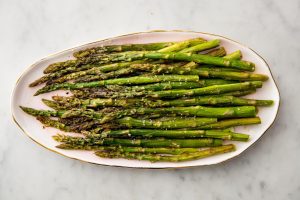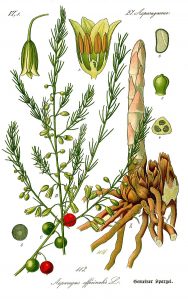 Although the chilly weather on Sunday tried to make us think otherwise, Spring is here. Daffodils, tulips, and hyacinths are popping up everywhere. Evil rabbits are starting to decimate the buds and tender new plants popping up in your yard. Squirrels are digging holes in your yard for no apparent reason (there must be something there, you just have no idea what). Forsythia are bursting with beautiful yellow flowers from root to tip. The pink-speckled bark of Redbuds reminds you of the beauty that is right around the corner. And the delicate tips of Asparagus spears begin to poke through the moist soil.One of the very first signs of Spring in a vegetable garden is the appearance of tender shoots of asparagus. The herbaceous, flowering perennial plant is one of my all-time favorite foods, and so I look forward to this time of year with intense longing. Unfortunately, the season for Asparagus is very short, just a few weeks or a month if you’re lucky, so make sure to track down local asparagus from local farmers, friends, neighbors, random people you see walking their dogs…just ask anyone. Once the season has passed, you can always find it in the grocery store, and with summer grilling season soon upon us there can never be enough of those deliciously tender stalks.
Although the chilly weather on Sunday tried to make us think otherwise, Spring is here. Daffodils, tulips, and hyacinths are popping up everywhere. Evil rabbits are starting to decimate the buds and tender new plants popping up in your yard. Squirrels are digging holes in your yard for no apparent reason (there must be something there, you just have no idea what). Forsythia are bursting with beautiful yellow flowers from root to tip. The pink-speckled bark of Redbuds reminds you of the beauty that is right around the corner. And the delicate tips of Asparagus spears begin to poke through the moist soil.One of the very first signs of Spring in a vegetable garden is the appearance of tender shoots of asparagus. The herbaceous, flowering perennial plant is one of my all-time favorite foods, and so I look forward to this time of year with intense longing. Unfortunately, the season for Asparagus is very short, just a few weeks or a month if you’re lucky, so make sure to track down local asparagus from local farmers, friends, neighbors, random people you see walking their dogs…just ask anyone. Once the season has passed, you can always find it in the grocery store, and with summer grilling season soon upon us there can never be enough of those deliciously tender stalks.
Do you like asparagus? Do you hate it? Do you just think it’s weird because it makes your pee smell and so you avoid eating it? No matter what your thoughts on asparagus are, hopefully, you will take some of the information below and try something new. So, without further ado, here are some tips on asparagus.
Did you know…
 Asparagus (Asparagus officinalis) is related to garlic, onions, and other members of the lily family, though Asparagus is no longer classified as part of the lily family (Liliaceae). In fact the lily family has been split and the onion-like plants are now in the family Amaryllidaceae and asparagus is in the family Asparagaceae. Though typically green there is also white asparagus which is kept white by mounding earth around the plant as it grows, a technique called blanching. With no access to sunlight, the asparagus stays white and is considered more tender.
Asparagus (Asparagus officinalis) is related to garlic, onions, and other members of the lily family, though Asparagus is no longer classified as part of the lily family (Liliaceae). In fact the lily family has been split and the onion-like plants are now in the family Amaryllidaceae and asparagus is in the family Asparagaceae. Though typically green there is also white asparagus which is kept white by mounding earth around the plant as it grows, a technique called blanching. With no access to sunlight, the asparagus stays white and is considered more tender.
Nutritional Information
Asparagus is low in calories, containing no fat and approximately 35 calories per one-cup serving, and very low in sodium. It is a very good source of dietary fiber, protein, beta-carotene, vitamin C, vitamin E, vitamin K, thiamin, riboflavin, niacin, folic acid, iron, phosphorus, potassium, copper, manganese, and selenium, as well as chromium, a trace mineral that enhances the ability of insulin to transport glucose from the bloodstream into cells. Raw asparagus also ranks highly in vitamins A, B-complex, and C, though during the cooking process some of the B-complex and C vitamins are lost.
Buying and Storing Asparagus
When looking for asparagus, seek out firm stalks without wrinkling. Stalks will vary widely in width which is only an indicator of age. Pencil-thin stalks are much younger than thicker ones and are typically much more tender. Thinner stalks also require shorter cooking times and tend to be less woody. After purchasing asparagus, wrap in a damp cloth and store in the vegetable/crisper drawer, or, bundle spears with a rubber band and place upright with the cut ends in a container with an inch of water. This will keep the spears vital until you can use them. Refrigerate immediately and use as soon as possible as asparagus’s sugars will turn rapidly to starches, reducing flavor quickly. Asparagus can also be pickled and stored for several years.
Preparation
Before cooking asparagus rinse the spears in cold water, dry, and cut or snap the bottoms of each spear off. Snapping the base is a technique used to remove the woody part of the asparagus as the spear will snap where the asparagus turns from tender to woody. Just bend the spear near the base and you should be able to snap it pretty easily, no knife required. If using this technique you may lose significantly more of the spear than if cutting the bottom. To avoid losing too much of the spear you can cut a small amount off the bottom and then peel the woody part before cooking. Thinner spears will not need much, if any, removed. An easy trick for a bunch of pencil-thin asparagus is to take the entire bunch of asparagus (with the rubber bands on) and simply cut ½-inch to 1 inch off the bottom of the entire bunch with a larger knife. White asparagus must be peeled before cooking.
Cooking
Asparagus can be eaten raw (look for younger, thinner spears to avoid toughness) and is delicious chopped and put on salads. Cut into inch long sections and add to stir-fry, omelets, pasta, quiche/frittata, or rice dishes. Asparagus goes well with parsley, tarragon, soy sauce, sesame, garlic, ginger, lemon, cream, eggs, Parmesan (or other hard, salty cheeses), and butter, lots and lots of butter.
Asparagus on its own is best cooked simply:
Blanching/shocking – Boil water using an electric kettle, stove-top kettle, or in a pot on the stove with some salt. Place spears in a bowl, saucepan, or baking dish and cover with boiling water. Let the spears sit in the water for 2-5 minutes. 2 minutes for super-thin spears and 5 minutes for thick spears. Asparagus should be tender and bright green when it’s ready. At that point, strain asparagus and run under cold water or submerge in ice water to halt the cooking process. This is called shocking. The entire process of blanching is used to reduce the loss of quality over time while maintaining flavor, color, and nutritional value. (For more information on blanching check out the Wikipedia page)
Steam – Use a steamer basket in a tall pot. Put about an inch of water in the pot and bring it to a boil. Place the asparagus upright in the pot and put the lid back on. Steam asparagus for 10 minutes or until tender (depends on thickness). You can also steam asparagus on its side if you don’t have a tall pot, but it can cook unevenly so just be careful and rearrange the spears every so often with tongs to prevent the ones on the bottom from getting overcooked.
Sauteéing – Heat a tablespoon of oil or grease (bacon fat works very well) in a skillet or saute pan. Place whole spears (this will require a wider pan) or cut asparagus in the pan once the oil is hot. Sauté the asparagus until tender. Some browning is always good.
Roasting – Arrange spears on a baking sheet (spread them out so you only have one layer), drizzle with olive oil, sprinkle with salt and pepper and roast in the oven until the skin starts to crisp and appears slightly shriveled and is just browning. At 500°F this will only take about 6-8 minutes. Increase the cooking time if you’re roasting at 450°F or 475°F. Careful using glass baking dishes at high heats as they can break. Sprinkle with lemon juice before serving. Can be served hot or cold.
Recipes
Ina Garten’s Roasted Asparagus (https://www.foodnetwork.com/recipes/ina-garten/roasted-asparagus-recipe-1916355)
Stir-fried Asparagus (https://www.allrecipes.com/recipe/25276/stir-fried-asparagus/)
Asparagus Salad (https://www.myrecipes.com/recipe/cherry-tomato-asparagus-salad)
Spring Asparagus Tart (https://www.thelandconnection.org/spring-asparagus-tart)
Information
Wikipedia – Asparagus (https://en.wikipedia.org/wiki/Asparagus)
TLC Blog – Asparagus (https://www.thelandconnection.org/blog/asparagus)
Illinois Specialty Crop Card Series – Asparagus (https://www.thelandconnection.org/sites/default/files/Specialty%20Crop%20Card_Asparagus.pdf)


